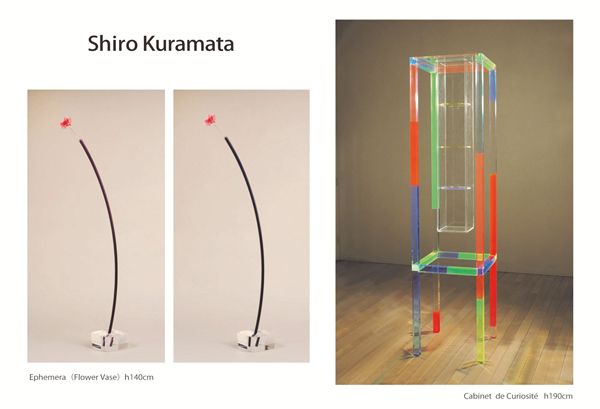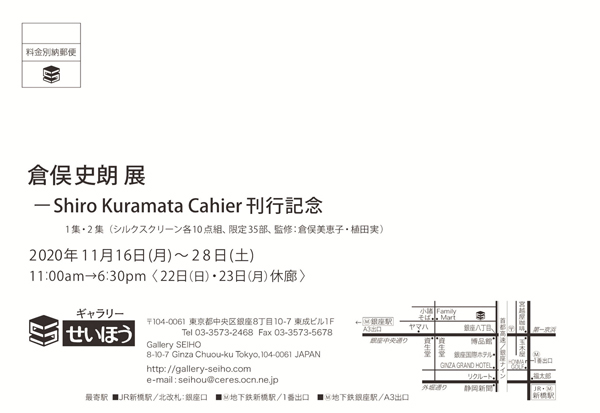Shiro Kuramata Cahier Publication Commemorative ExhibitionVenue: Ginza・Gallery Seiho |
To view the movie, please click the play icon on the center of movie below.
Shiro Kuramata Cahier Publication Commemorative Movie
  *Click images to view in original size. |
Location:Gallery Seiho
(Tokyo-to, Chuo-ku, Ginza 8-10-7 Higashinari Bldg 1 F)
Gallery view
 |
|
 |
|
 |
|
 |
|
 |
|
 |
|
 |
|
 |
|
 |
|
 |
|
 |
|
 |
|
 |
|
 |
|
 |
|
 |
|
 |
|
 |
|
| Photographer: SHIONO Tetsuya | |
KURAMATA Shiro is a world class designer who made revolutionary works in the fields of interior and spacial design since the 1960s. He often used acrylic, glass, aluminum, and steel mesh; with acrylic, a medium he favored all his life, he created many transparent, ethereal works that imbued a weightless feeling into every day spaces. Next year will be the 30th anniversay of Kuramata's sudden passing in 1991; even today, his originality and unique presence are highly regarded across the globe, and he remains a great inspiration to a young generation of creators who may be unaware of his contemporaries.
Toki-no-Wasuremono has published volumes 1 and 2 of "Shiro Kuramata Cahier", a collection of silkscreen prints of selected sketches that Kuramata left behind. To commemorate their release, "Shiro Kuramata Cahier Publication Commemorative Exhibition" will be held at Gallery Seiho. The collection was supervised by Kuramata's widow, KURAMATA Mieko, and UYEDA Makoto, who edited the catalog for "Shiro Kuramata Exhibition" that began at Hara Museum of Contemporary Art and traveled through the USA and Europe from 1996-1999. Volumes 1 and 2 each include ten silkscreen prints printed by ISHIDA Ryoichi.
This exhibition includes the works of volumes 1 and 2 of "Shiro Kuramata Cahier", the experimental chair "How High the Moon", one of Kuramata's representative works, the floating, transparent cabinet, "Cabinet de Curiosite", and others. His most representative work, "Miss Blanche" (1988), and mock ups of perfume bottles he designed for Issey Miyake will also be on display.
■KURAMATA Shiro (1934-1991)
In the late 1960s Kuramata became a global designer known for his innovative works. These include many pieces which use a mix of diverse mediums including acrylic, glass, aluminum, and steel mesh. He was born in Tokyo in 1934. He attended the Tokyo Metropolitan Kogei High School and began work at Teikoku Kuzai in 1953. From 1953 to 1956 he studied at Kuwasawa Design Research Center, Department of Living Design, and in 1957 moved to Mie Prefecture to work in advertising, creating window displays. In 1956 he began his own office, Kuramata Design. In 1967 he gained attention after collaborating with Tadanori Yokoo on an interior design project.
From around this time, he started to use the acrylic that he would favor for the rest of his life, creating transparent, weightless works emulating that cloating space of everyday life. Kuramata gained international recognition with his 1970 series "Furniture in Irregular Forms". He was awarded the Mainichi Design Prize in 1972. In 1981 he participated in an exhibition in Memphis set up by Ettore Sottssas Jr., showing works as part of a new Italian design movement alongside Arata Isozaki and Michael Graves. He was awarded the French Order of Culture in 1990. He suffered from heart failure in 1991 and passed away at the age of 56.
